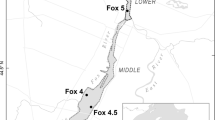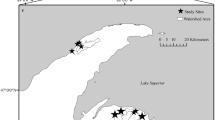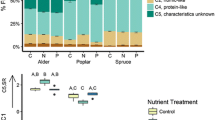Abstract
Dissolved organic matter (DOM) is an important component of aquatic food webs. We compare the uptake kinetics for NH4–N and different fractions of DOM during soil and salmon leachate additions by evaluating the uptake of organic forms of carbon (DOC) and nitrogen (DON), and proteinaceous DOM, as measured by parallel factor (PARAFAC) modeling of DOM fluorescence. Seasonal DOM slug additions were conducted in three headwater streams draining a bog, forested wetland, and upland forest using DOM collected by leaching watershed soils. We also used DOM collected from bog soil and salmon carcasses to perform additions in the upland forest stream. DOC uptake velocity ranged from 0.010 to 0.063 mm s−1 and DON uptake velocity ranged from 0.015 to 0.086 mm s−1, which provides evidence for the whole-stream uptake of allochthonous DOM. These findings imply that wetlands could potentially be an important source of DOM to support stream heterotrophic production. There was no significant difference in the uptake of DOC and DON across the soil leachate additions (P > 0.05), although differential uptake of DOM fractions was observed as protein-like fluorescence was removed from the water column more efficiently than bulk DOC and DON (P < 0.05). Moreover, PARAFAC analysis of DOM fluorescence showed that protein-like fluorescence decreased downstream during all DOM additions, whereas humic-like fluorescence did not change. This differential processing in added DOM suggests slow and fast turnover pools exist for aquatic DOM. Taken together, our findings argue that DON could potentially fill a larger role in satisfying biotic N demand in oligotrophic headwater streams than previously thought.




Similar content being viewed by others
References
Alexander RB, Smith RA, Schwartz GE. 2000. Effect of stream channel size on the delivery of nitrogen to the Gulf of Mexico. Nature 403:758-61.
Amon RMW, Meon B. 2004. The biogeochemistry of dissolved organic matter and nutrients in two large Arctic estuaries and potential implications for our understanding of the Arctic Ocean system. Mar Chem 92:311-30.
Baker A. 2001. Flourescence excitation-emission matrix characterization of some sewage-impacted rivers. Environ Sci Technol 35:948-53.
Battin TJ, Kaplan LA, Newbold JD, Hansen CME. 2003. Contributions of microbial biofilms to ecosystem processes in stream mesocosms. Nature 426:439-42.
Bernhardt ES, Likens GE. 2002. Dissolved organic carbon enrichment alters nitrogen dynamics in a forest stream. Ecology 83(6):1689-700.
Bormann FH, Likens GE. 1967. Nutrient cycling. Science 155:424-9.
Brookshire EN, Valett JHM, Thomas SA, Webster JR. 2005. Coupled cycling of dissolved organic nitrogen and carbon in a forest stream. Ecology 86(9):2487-96.
Butturini A, Sabater F. 1998. Ammonium and phosphate retention in a Mediterranean stream: hydrological versus temperature control. Can J Fish Aquat Sci 55:1938-45.
Campbell JL, Hornbeck JW, McDowell WH, Buso DC, Shanley JB Likens GE. 2000. DON budgets for upland, forested ecosystems in New England. Biogeochemistry 49:123-42.
Cory RM, McKnight CM. 2005. Fluorescence spectroscopy reveals ubiquitous presence of oxidized and reduced quinones in DOM. Environ Sci Technol 39:8142-9.
Ellis BD, Butterfield P, Jones WL, McFeters GA, Camper AK. 2000. Effects of carbon source, carbon concentration, and chlorination on growth related parameters of heterotrophic biofilm bacteria. Microb Ecol 38:330-47.
Fellman JB, D’Amore DV, Hood E, Boone RD. 2008a. Fluorescence characteristics and biodegradability of dissolved organic matter in forest and wetland soils from coastal temperate watersheds in southeast Alaska. Biogeochemistry 88:169-84.
Fellman JB, Hood E, Edwards RT, D’Amore DV. 2008b. Return of salmon-derived nutrients from the riparian zone to the stream during a storm in SE Alaska. Ecosystems 11:537-44.
Fiebig DM. 1997. Microbiological turnover of amino acids immobilized from groundwater discharged through hyporheic sediments. Limnol Oceanogr 42:763-8.
Findlay SEG, Sinsabaugh RL. 2003. Response of hyporheic biofilm metabolism and community structure to nitrogen amendments. Aquat Microb Ecol 33:127-36.
Findlay SEG, Sinsabaugh RL, Sobczak WV, Hoostal M. 2003. Metabolic and structural response of hyporheic microbial communities to variations in supply of dissolved organic matter. Limnol Oceanogr 48(4):1608-17.
Fisher H, Sachse A, Steinberg CEW, Pusch M. 2002. Differential retention and utilization of dissolved organic carbon by bacteria in river sediments. Limnol Oceanogr 47(6):1702-11.
Gordon ND, McMahon TA, Finlayson BL. 1992. Stream hydrology: an introduction of ecologists. John Wiley & Sons Ltd, West Sussex, England.
Green SA, Blough NV. 1994. Optical absorption and fluorescence properties of hromophoric DOM in natural waters. Limnol Oceanogr 39:1903-16.
Hall RO Jr., Tank JL. 2003. Ecosystem metabolism controls nitrogen uptake in streams in Grand Teton National Park, Wyoming. Limnol Oceanogr 48(3):1120-8.
Hedin LO, Armesto JJ, Johnson AH. 1995. Patterns of nutrient loss from unpolluted, old-growth temperate forests: evaluation of biogeochemical theory. Ecology 76:493-509.
Hood E, Fellman JB, Edwards RT. 2007. Salmon influences on DOM in a coastal temperate brown-water stream. Limnol Oceanogr 52(4):1580-7.
Judd KE, Crump BC, Kling GW. 2006. Variation in dissolved organic matter controls bacterial production and community composition. Ecology 87(8):2068-79.
Kaplan LA, Bott TL. 1983. Microbial heterotrophic utilization of dissolved organic matter in a piedmont stream. Fresh Biol 13:363-77.
Kaplan LA, Newbold JD. 2003. The role of monomers in stream ecosystem metabolism. In: Findlay SEG, Sinsabaugh RL, Eds. Aquatic Ecosystems: interactivity of dissolved organic matter. San Diego, CA: Academic Press. p 97-120.
Kuzyakov YV. 1997. The role of amino acids and nucleic bases in turnover of nitrogen and carbon in soil humic fractions. Europ J Soil Sci 48:121-30.
McDowell WH. 1985. Kinetics and mechanisms of dissolved organic carbon retention in a headwater stream. Biogeochemistry 1:329-52.
McDowell WH. 2003. Dissolved organic matter in soils – future directions and unanswered questions. Geoderma 113:179-186.
McKnight DM, Smith RL, Harnish RA, Miller CL, Bencala KE. 1993. Seasonal relationships between planktonic microorganisms and DOM in a stream. Biogeochemistry 21:39-59.
McKnight DM, Hornberger GM, Bencala KE, Boyer EW. 2002. In-stream sorption of fulvic acid in an acidic stream: a stream-scale transport experiment. Water Resourc Res 38(1):1005, 10.1029/2001WR000269.
Mulholland PJ, Tank JL, Webster JR, Bowden WB, Dodds WK, Gregory SV, Meyer NB, Peterson BJ, Valett HM, Wollheim WM. 2002. Can uptake length in streams be determined by nutrient addition experiments? Results from an interbiome comparison study. J N Am Benthol Soc 21(4):544-60.
Mulholland PJ, Thomas SA, Valett HM, Webster JR, Beaulieu J. 2006. Effects of light on nitrate uptake in small forested streams: diurnal and day-to-day variations. J N Am Benthol Soc 25(3):583-95.
Murphy J, Riley JP. 1962. A modified single solution method for the determination of phosphate in natural waters. Anal Chim Acta 27:31-6.
National Wetlands Working Group (NWWG). 1988. Wetlands of Canada. Ecological Land Classification Series 24. Environment Canada, Sustainable development branch, Ottawa, Canada
Newbold JD, Elwood JW, O’Neill RV, Van Winkle W. 1981. Measuring nutrient spiraling in streams. Can J Fish Aquat Sci 38:860-3.
Newbold JD, Bott TL, Kaplan LA, Dow CL, Jackson JK, Aufdenkampe AK, Martin LA, Van Horn DJ, de Long AA. 2006. Uptake of nutrients and organic C in streams in New York City drinking-water-supply watersheds. J N Am Benthol Soc 25(4):998-1017.
Simon KS, Townsend CR, Biggs BJF, Bowden WB. 2005. Variation of N and P uptake in New Zealand streams. J N Am Benthol Soc 24(1):1-18.
Sobczak WV, Findlay SEG, Dye S. 2003. Relationships between DOC bioavailability and NO3 removal in an upland stream: An experimental approach. Biogeochemistry 62:309-27.
Stedmon CA, Markager S. 2005. Tracing the production and degradation of autochthonous fractions of DOM by fluorescence analysis. Limnol Oceanogr 50(5):1415-26.
Stedmon CA, Markager S, Bro R. 2003. Resolving the variability in DOM fluorescence in a temperate estuary using PARAFAC analysis. Limnol Oceanogr 50(2):686-97.
Stream Solute Workshop. 1990. Concepts and methods for assessing solute dynamics in stream ecosystems. J N Am Benthol Soc 9:95-119.
Triska FJ, Jackman AP, Duff JH, Avanzino RJ. 1994. Ammonium sorption to channel and riparian sediments: a transient storage pool for dissolved inorganic nitrogen. Biogeochemistry 26:67-83.
USDA. 1997. Tongass National Forest Land and Resource Management Plan. R10-MV-338dd. USDA Forest Service, Region 10, Juneau, AK, USA.
Vitousek PM, Reiners WW. 1975. Ecosystem succession and nutrient retention: A hypothesis. Bioscience 25(6):376-81.
Weishaar JL, Aiken GR, Bergamaschi BA, Fram MS, Fujil R. 2003. Evaluation of specific ultraviolet absorbance as an indicator of the chemical composition and reactivity of dissolved organic carbon. Environ Sci Technol 37:4702-8.
Wickland KP, Neff JC, Aiken GR. 2007. DOC in Alaskan boreal forests: sources, chemical characteristics, and biodegradability. Ecosystems 10:1323-40.
Wiegner TN, Kaplan LA, Newbold JD, Ostrom PH. 2005. Contribution of DOC to stream metabolism: a mesocosm study using 13C enriched tree-tissue leachate. J N Am Benthol Soc 24(1):48-67.
Xenopoulos MA, Lodge DM, Frentress J, Kreps TA, Bridgham SD, Grossman E, Jackson DJ. 2003. Regional comparisons of watershed determinants of DOC in temperate lakes from the Upper Great Lakes region. Limnol Oceanogr 48(6):2321-34.
Yamashita Y, Jaffe R. 2008. Characterizing the interactions between trace metals and DOM using excitation-emission matrix and Paralled factor analysis. Environ Sci Technol 42:7374–9.
Yamashita Y, Tanoue E. 2003. Chemical characterization of protein-like fluorophores in DOM in relation to aromatic amino acids. Mar Chem 82:255-71.
ACKNOWLEDGEMENTS
The authors wish to acknowledge Karen Michael and Erik Norberg for their laboratory and field assistance. We also thank the anonymous reviewers for insightful comments that improved this manuscript. This study was funded by the USDA National Research Initiative, grant number 2005-35102-16289, the USDA Forest Service, Resource Management and Productivity Program and the Aquatic and Land Interactions Program at the Pacific Northwest Research Station in Juneau, AK. The use of trade or firm names in this publication is for reader information and does not imply endorsement by the U.S. Department of Agriculture of any product or service.
Author information
Authors and Affiliations
Corresponding author
Additional information
Author contributions
J.B.F. conceived of or designed study, performed research, analyzed data, contributed new methods or models, and wrote the paper. E.H. conceived of or designed study and analyzed data. R.T.E. conceived of or designed study and analyzed data. J.B.J. contributed new methods or models and analyzed data.
Electronic supplementary material
Below is the link to the electronic supplementary material.
Rights and permissions
About this article
Cite this article
Fellman, J.B., Hood, E., Edwards, R.T. et al. Uptake of Allochthonous Dissolved Organic Matter from Soil and Salmon in Coastal Temperate Rainforest Streams. Ecosystems 12, 747–759 (2009). https://doi.org/10.1007/s10021-009-9254-4
Received:
Revised:
Accepted:
Published:
Issue Date:
DOI: https://doi.org/10.1007/s10021-009-9254-4




